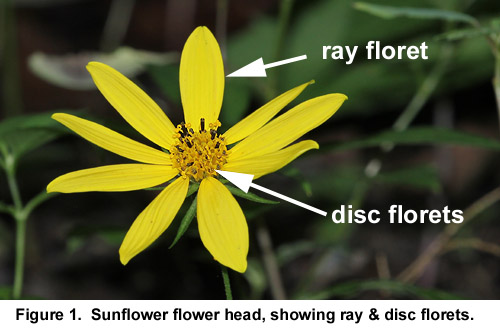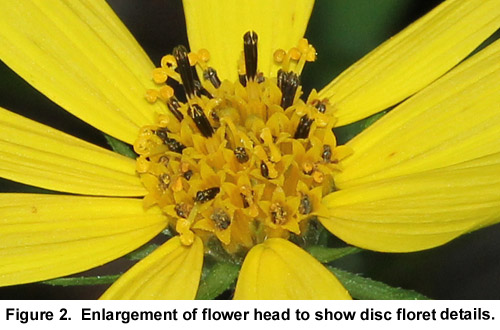 |
 |
|
Included in this key are only those species found in the area surveyed at Buttermilk Falls State Park. |
||||
|
. ** Plant
Finder ** |
||||
| .Home | Go Back | |||
|
A
crash
course
in
Composite |
||||
|
|
|
|
|
|
Flowers of plants in the Composite family, including daisies, sunflowers, coneflowers, dandelions and many others, are arranged into "flower heads". We call these small flowers "florets". There may be anywhere from a few to many florets in a flower head. Viewed from above, the flower heads are round in cross-section. The florets in a given flower head may all be similar in shape to each other, or they may be of two different types: those with "rays" and those lacking rays. |
|
 |
 |
|
|
|
|
|
Ray florets are always located around the circumference of the disc. Disc florets comprise the central portion of the disc. Depending on the species, ray florets may be bisexual, pistillate (female) or sterile (lacking reproductive parts). Ray florets shown in Figure 2 are sterile. Disc florets shown in Figure 2 are bisexual. The dark brown parts shown are the anthers (pollen bearing) and the dark yellow, curled parts are the styles (female). The sunflower shown above illustrates one type of flower head: with both ray and disc florets. Note that the tips of the ray florets in Figure 1 do not have prominent "teeth" (notches). Figure 3 (below) shows a second type of flower head, one with florets that are all basically the same in shape. Note that the florets are also all the |
|
|
|
|
same color. The florets around the circumference of the disc are just a bit larger and spread outward more widely than those in the center. All florets in this sample flower head are bisexual and fertile, and tips of the florets have five minute teeth. The anthers are difficult to discern because they're slender and yellow in color, unlike those of the sunflower in figures 1 and 2, which are dark brown. Rattlesnake weed is a member of a large class of composite family species, very similar to the common dandelion, that have "milky" sap. If the tissues become injured, a whitish sap is exuded. That's a good diagnostic character. The technical term for this type of floret is "ligule" (meaning "little tongue"). The third major type of composite flower head is rayless, meaning that none of the florets possess a ray or a ligule. In other words, all florets are "disc florets". For this group of species, most of the florets are bisexual or pistillate (female). However, both types may occur in the same flower head, as in Figures 4 and 5 (below). |
||
|
|
|
|
|
x |
|
>>> Continue to Part 2 <<< |
x
x
x
|
Images and text copyright Arieh Tal, 2017-2022. All rights reserved. ( Terms of Use ) |